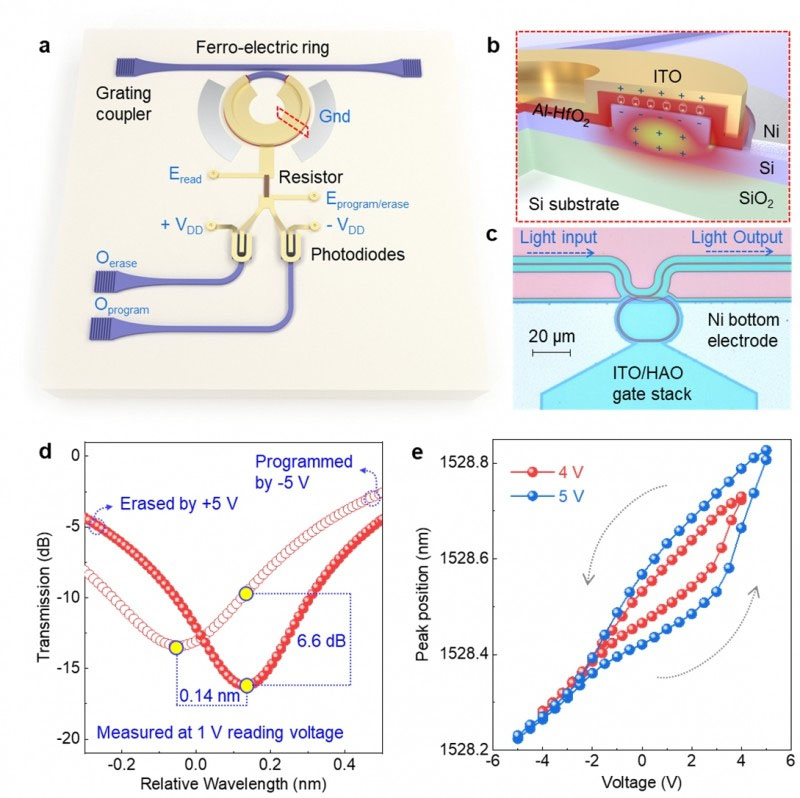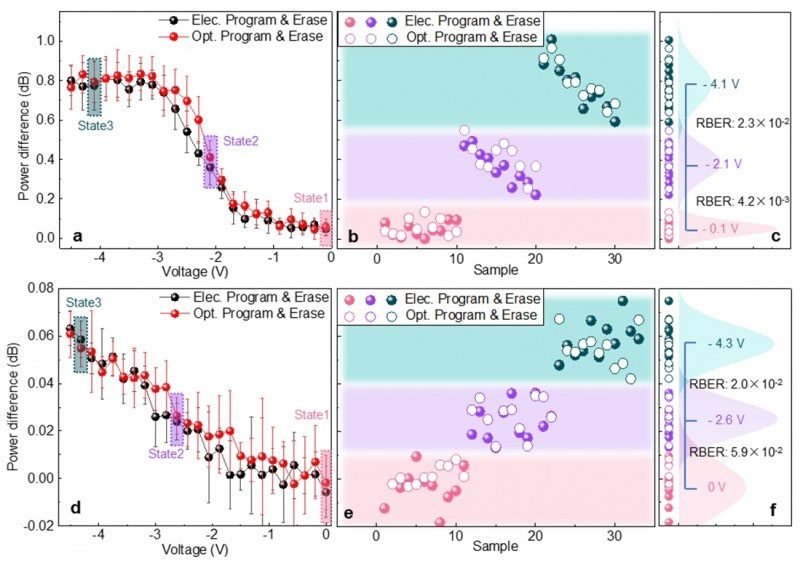| Sep 10, 2024 |
Breakthrough in non-volatile photonic-electronic memory with thin-film ferroelectrics
(Nanowerk News) An international research team, led by Professor Gong Xiao from the National University of Singapore, has achieved a groundbreaking advancement in photonic-electronic integration. Their work, published in Light: Science & Applications ("Thin film ferroelectric photonic-electronic memory"), features Postdoc Zhang Gong and PhD student Chen Yue as co-first authors. They developed a non-volatile photonic-electronic memory chip utilizing a micro-ring resonator integrated with thin-film ferroelectric material.
|
|
This innovation successfully addresses the challenge of dual-mode operation in non-volatile memory, offering compatibility with silicon-based semiconductor processes for large-scale integration. The chip operates with low voltage, boasts a large memory window, high endurance, and multi-level storage capabilities. This breakthrough is poised to accelerate the development of next-generation photonic-electronic systems, with significant applications in optical interconnects, high-speed data communication, and neuromorphic computing.
|
|
As big data and AI grow, traditional computers struggle with large-scale tasks. Photonic computing offers potential, but interfacing with electronic chips is challenging. Current storage can't handle dual-mode operations, and OEO conversion adds losses and delays. A non-volatile memory for efficient data exchange between photonic and electronic chips is essential.
|
 |
| Figure 1. (a) Schematic of memory structure based on micro-ring resonator. (b) Cross-sectional schematic of the memory. (c) Microscopic photo of the memory. (d) Optical spectrum of the memory in two states. (e) Optical hysteresis loops of the memory. (© Light: Science & Applications)
|
|
The discovery of ferroelectricity in doped hafnium oxide thin films offers new opportunities for advancing ferroelectric memory technologies. Unlike traditional ferroelectric materials in complex perovskite systems, doped hafnium oxide is highly compatible with silicon-based semiconductor processes, providing high scalability, long retention, and reliable ferroelectric properties even at nanometer-scale thicknesses. The non-volatile, multi-level photonic memory demonstrated in this study is set to become a critical technology for integrating electronic and photonic circuits.
|
|
Professor Gong Xiao’s team from the Department of Electrical and Computer Engineering at the National University of Singapore has developed a non-volatile photonic-electronic memory by integrating hafnium oxide-based ferroelectric material with silicon photonics. As depicted in Figure 1, this memory utilizes external voltage to control the remnant polarization within the ferroelectric layer, enabling data programming and erasing. Changes in remnant polarization affect the memory’s capacitance and the refractive index of the silicon waveguide, allowing information to be accessed both electrically and optically.
|
|
Moreover, by finely adjusting the programming voltage, the polarization state of the ferroelectric layer can be precisely tuned to support multi-level storage. The memory, built on a silicon micro-ring resonator, can be programmed and erased using both electrical and optical methods, exhibiting a high optical extinction ratio, low operating voltage, and impressive durability.
|
 |
| Figure 2. (a-c) Writing using both electrical and optical signals. Then, reading using optical signals. (d-f) Writing using both electrical and optical signals. Then, reading using electrical signals. (© Light: Science & Applications)
|
|
Detailed analysis of its multi-level storage capability revealed an exceptionally low error probability, confirming the memory’s stability and functionality. The team also rigorously tested the memory cell’s durability and retention time, addressing gaps found in previously reported non-volatile photonic memories.
|
|
This achievement represents a major step toward realizing high-performance, low-energy photonic-electronic integrated systems. It provides a critical foundation for the development of photonic-electronic systems and is expected to drive innovation in next-generation data centers, high-speed communication networks, neural network computing, and high-performance computing. As integration improves and manufacturing processes mature, these chips are anticipated to become core components of future photonic-electronic systems, ushering in a new era for information technology.
|


